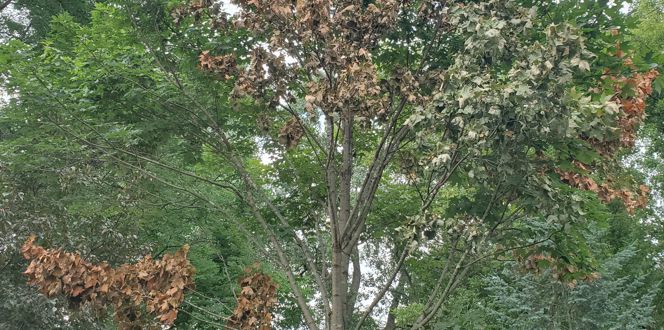Pine trees are great additions to your landscape.
Not only are they green all year long, adding a unique texture and color to your yard during every season, but they are also easy to grow and maintain. With proper watering, fertilizing, mulching, and pruning, pines are fairly hardy.
Occasionally, though, pine trees can be the victims of browning needle tips, sometimes caused by a disease known as Diplodia tip blight.
Recognizing this damage and its causes are the first steps to troubleshooting your pine health problems.
What Is Diplodia Tip Blight?
The Diplodia fungus is actually one of the most visible diseases in your pine trees. It stands out because it causes the tips of your favorite pine needles to brown.
The Diplodia fungus spends its winters on the cones and dead needles of pine trees. In spring, it begins to spread through spores, spreading most easily during rainy, humid days. It spreads throughout the growing season from March to October and targets new growth of your pines.
Pine trees tend to be most susceptible to Diplodia infection when under stress, particularly trees suffering from drought or inadequate soil conditions. The fungus also prefers trees weakened by hail or snow damage, overshading, compacted roots, and even insect infestation.
Diplodia Fungus Symptoms
The first, and biggest, symptom of Diplodia tip blight is new pine needles turning brown in spring. This often starts on the lower half of the tree, progressing upward.
Then, if you look closely at your pine in summer and fall, you will see the black fruiting bodies of the Diplodia fungus -- black dots on the bottoms of the needles, stems, and pine cone scales. They look sort of like black pepper flakes.
If the tip blight is severe, you may also see dead branches and/or wounds on impacted branches.
Pine Trees At Risk
Diplodia tip blight likes pine trees that are older, with the most severe symptoms observed on trees that are over 25 to 30 years old. Pines younger than 15 years old are less affected.
When it comes to types of pines, this fungus has its preferences. Consider these the most susceptible pine trees:
- Austrian pine
- Scots pine
- Red pine
- Mugo pine
- Ponderosa pine
- Eastern white pine
Other types of evergreens are also at risk. Susceptible conifers include:
- Douglas fir
- Norway spruce
- Colorado blue spruce
- Noble fir
- Silver fir
- Arborvitae
- Juniper
Diplodia Tip Blight Management
Because this fungus impacts your most stressed trees, keeping them healthy is the first and most important step to Diplodia tip blight management.
Good preventative management strategies include irrigating properly throughout the year, as well as mulching to help the soil retain moisture during dry seasons. Lastly, proper pruning while the trees are dry can help remove brown areas, maintain shape, and perk up appearance while minimizing spread of the fungus.
Once It Attacks Your Beloved Pine, How Is Diplodia Tip Blight Treated?
Diplodia tip blight treatment starts with fungicide applications by a tree care professional. Timing is crucial so you strike the disease at the right time to prevent too much spread of the spores and dieback of the pine needles.
For adequate Diplodia tip blight management, you’ll receive a series of fungicide treatments beginning in early spring just as new needles begin to develop.







